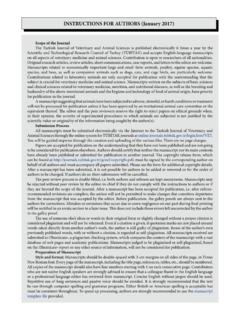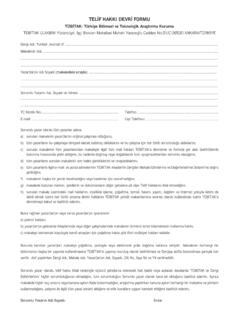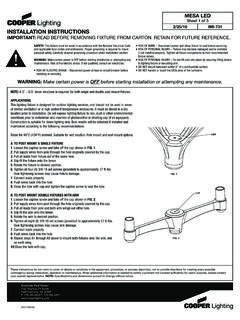Transcription of INSTRUCTIONS FOR AUTHORS (January 2017) - …
1 INSTRUCTIONS FOR AUTHORS (January 2017) Scope of the JournalThe Turkish Journal of Medical Sciences is published electronically 6 times a year by the Scientific and Technological Research Council of Turkey (T B TAK) and accepts English-language manuscripts in all fields of medicine and related health sciences. Contribution is open to researchers of all nationalities. The following types of papers are welcome: original articles (for the presentation of clinical and laboratory studies), review articles (by invitation only), and letters to the editor. Submission ProcessAll manuscripts must be submitted electronically via the Internet to the Turkish Journal of Medical Sciences through the online system for T B TAK journals at You will be guided stepwise through the creation and uploading of the various files. There are no page are accepted for publication on the understanding that they have not been published and are not going to be considered for publication elsewhere.
2 AUTHORS should certify that neither the manuscript nor its main contents have already been published or submitted for publication in another journal. The copyright release form, which can be found at , must be signed by the corresponding author on behalf of all AUTHORS and must accompany all papers submitted. Please see the form for additional copyright details. After a manuscript has been submitted, it is not possible for AUTHORS to be added or removed or for the order of AUTHORS to be changed. If AUTHORS do so, their submission will be peer review process is double-blind, both AUTHORS and referees are kept anonymous. Manuscripts may be rejected without peer review by the editor-in-chief if they do not comply with the INSTRUCTIONS to AUTHORS or if they are beyond the scope of the journal. Any manuscript that does not conform to the Uniform Requirements for Manuscripts Submitted to Biomedical Journals, as reported at , will also be rejected.
3 After a manuscript has been accepted for publication, after referee-recommended revisions are complete, the author will not be permitted to make changes that constitute departures from the manuscript that was accepted by the editor. Before publication, the galley proofs are always sent to the AUTHORS for corrections. Mistakes or omissions that occur due to some negligence on our part during final printing will be rectified in an errata section in a later issue. This does not include those errors left uncorrected by the author in the galley use of someone else s ideas or words in their original form or slightly changed without a proper citation is considered plagiarism and will not be tolerated. Even if a citation is given, if quotation marks are not placed around words taken directly from another author s work, the author is still guilty of plagiarism. Reuse of the author s own previously published words, with or without a citation, is regarded as self-plagiarism.
4 All manuscripts received are submitted to iThenticate , a plagiarism checking system, which compares the content of the manuscript with a vast database of web pages and academic publications. Manuscripts judged to be plagiarised or self-plagiarised, based on the iThenticate report or any other source of information, will not be considered for of ManuscriptStyle and format: Manuscripts should be double-spaced with 3-cm margins on all sides of the page, in Times New Roman font. Every page of the manuscript, including the title page, references, tables, etc., should be numbered. All copies of the manuscript should also have line numbers starting with 1 on each consecutive page. Manuscripts should be written in English. Contributors who are not native English speakers are strongly advised to ensure that a colleague fluent in the English language or a professional language editor has reviewed their manuscript. Concise English without jargon should be used.
5 Repetitive use of long sentences and passive voice should be avoided. It is strongly recommended that the text be run through computer spelling and grammar programs. Either British or American spelling is acceptable but must be consistent throughout. To speed up processing, AUTHORS are strongly recommended to use the manuscript template file , units, and abbreviations: In general, the journal follows the conventions of Scientific Style and Format, The CSE Manual for AUTHORS , Editors, and Publishers, Council of Science Editors, Reston, VA, USA (7th ed.). If symbols such as , , , or are used, they should be added using the Symbols menu of Word. Degree symbols ( ) must be used from the Symbol menu, not superscripted letter o or number 0. Multiplication symbols must be used ( ), not the letter x. Spaces must be inserted between numbers and units ( , 3 kg) and between numbers and mathematical symbols (+, , , =, <, >), but not between numbers and percent symbols ( , 45%).
6 Please use SI units. All abbreviations and acronyms should be defined at first mention. Latin terms such as et al., in vitro, or in situ should not be content: Research articles should be divided into the following sections. Principal sections should be numbered consecutively (1. Introduction, 2. Materials and methods, etc.) and subsections should be numbered , , etc. Do not number the References sections. Please see below for information about other types of manuscripts. All submissions must include a title page, which is to be uploaded as a separate document. Do not repeat the information from the title page within the main manuscript page The title page should contain the full title in sentence case ( , Urothelial cancers: clinical and imaging evaluation), the full names (last names fully capitalised) and affiliations (in English) of all AUTHORS (Department, Faculty, University, City, Country), and the contact e-mail address for the clearly identified corresponding author.
7 Please include any necessary acknowledgements or disclaimers on the title page, as well. Do not repeat them in the main document. Names of funding organisations should be written in full. If your manuscript is accepted for publication, this information will be moved to the main document after the peer review process is and abstract The first page of the main manuscript should begin with the title. Do not include author names or affiliations here. Directly below the title, an informative abstract of not more than 200 words must accompany each manuscript. The abstract must be structured to include the study s background and aim, materials and methods, results, and conclusion under 4 separate headings. Abstracts of review articles should be a brief overview of the main points from the review. Key wordsPlease provide at least 3 key words or phrases to enable retrieval and indexing. Acronyms should be avoided. Always try to use terms from the Medical Subjects Headings list from Index Medicus.
8 IntroductionThis should argue the case for your study, outlining only essential background, and should not include the findings or the conclusions. It should not be a review of the subject area, but should finish with a clear statement of the question being addressed. Materials and methodsExplain clearly but concisely your clinical, technical, or experimental procedures. Previously published papers related to the methods should be cited with appropriate references. Brand names and company locations should be supplied for all mentioned equipment, instruments, chemicals, etc. ResultsFindings must be described without comment. The same data or information given in a Table must not be repeated in a Figure and vice versa. It is not acceptable to repeat extensively the numbers from Tables in the text or to give lengthy explanations of Tables or from the Introduction and Results sections should not be repeated here.
9 The final paragraph should highlight the main conclusions of the in the text should be identified by numbers in parentheses. The list of references at the end of the paper should be given in order of their first appearance in the text. All AUTHORS should be included in reference lists unless there are 10 or more, in which case only the first 10 should be given, followed by et al.. Do not use individual sets of parentheses for citation numbers that appear together, , (2,3,5 9), not (2),(3),(5) (9). Do not include personal communications, unpublished data, websites, or other unpublished materials as references, although such material may be inserted (in parentheses) in the text. In the case of publications in languages other than English, the published English title should be provided if one exists, with an annotation such as (article in Turkish with an abstract in English).
10 If the publication was not published with an English title, provide the original title only; do not provide a self-translation. References should be formatted as follows (please note the punctuation and capitalisation):Journal articles: Journal titles should be abbreviated according to ISI Web of Science kun , Erdem H, Avc A. Management of community-acquired acute bacterial cystitis in Turkey. Turk J Med Sci 2011; 41: AG, Zwahlen M, Minder C, O Dwyer ST, Shalet SM, Egger M. Insulin-like growth factor (IGF)-I, IGF binding protein-3, and cancer risk: systematic review and meta-regression analysis. Lancet 2004; 363: D. Modern Blood Banking & Transfusion Practices. 6th ed. Philadelphia, PA, USA: Davis Company; MK, Bond D. Gerontology and Leadership Skills for Nurses. 2nd ed. Albany, NY, USA: Delmar Publishers; of booksHolland SM, Gallin JI. Evaluation of the patient with suspected immunodeficiency.







